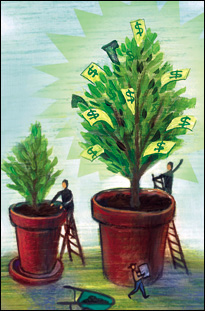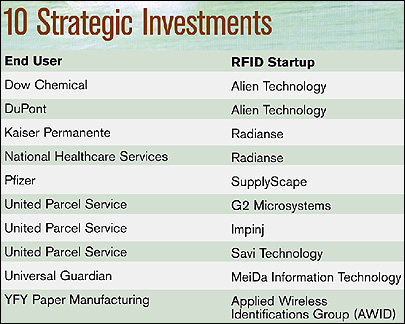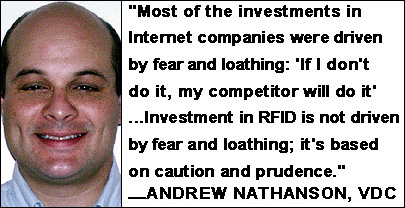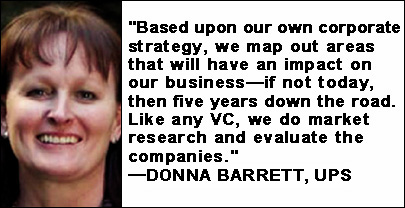When Pfizer contributed to an $8 million Series B investment in SupplyScape this May, the funds represented more than a cash infusion for the developer of anticounterfeiting RFID applications for the pharmaceutical industry. The investment from the Pfizer Strategic Investments Group was another marker of a growing trend. In less than one year, RFID technology firms have gotten a shot in the arm—to the tune of tens of millions of dollars—and not just from the usual suspects known as venture capitalists.
A slew of strategic investors are increasingly placing their bets on RFID companies, hoping to get more than a monetary return on their investment. They are current or future RFID customers that want to have a hand in how RFID solutions are developed and brought to market. They also want to improve their knowledge about the emerging technology, sharpen their business strategies and bolster their bottom line. Along with Pfizer, the list of end users that have invested in RFID includes Dow Chemical, DuPont, Kaiser Permanente and United Parcel Service (UPS).
“These [end-user] companies have specific needs [for applications] that will help them gain market share, improve operations or improve their competitive advantage,” says Andrew Nathanson, automatic identification and data capture practice director for technology market research firm Venture Development Corp. (VDC). The most recent strategic investments by end users, he says, “have been right on. They are good fits and good models, and both companies will benefit.”
When end users make strategic investments in enabling technologies—in this case, RFID—it sends a strong signal that there is a growing market for a given product segment. It’s also a key factor in moving RFID from research and development to deployment, analysts and industry watchers say.
“It’s a vote of confidence—and companies vote with dollars,” says Mark Johnson, president of RFID Tribe, a 2,000-member national association of RFID professionals that helps match its members with potential angel investors. “When end users are investing, in general they are investing in technologies that will be helpful to their company strategically.”
Strategic Thinking
Perhaps the most active end user to invest in RFID technology is United Parcel Service. “We make investments in companies in emerging technology areas for us,” says Donna Barrett, technology public relations manager for UPS. “And one area we’ve been monitoring for over a decade is RFID. The primary purpose for these minority investments is to gain knowledge and insight.”
UPS sees value in using RFID for certain applications, such as helping its clients manage their warehouses and track large, costly items or perishable goods. In fact, UPS considers investing in RFID technology firms one of the “four pillars” of its RFID strategy. In July, the UPS Strategic Enterprise Fund contributed to a $14 million investment pool led by Siemens Venture Capital for semiconductor maker G2 Microsystems. The funding will help G2 ramp up production of its real-time location systems for tracking and monitoring assets in the automotive, health-care, biopharmaceutical and chemical industries, among others. (UPS funded G2 in 2004 as well.)
G2 isn’t the only RFID company to get financial support from UPS. In December 2005, Impinj, a Gen 2 RFID tag maker, secured a $26.5 million round of funding from a group of investors that included UPS and was led by GF Private Equity Group. And in 2000, UPS invested in Savi Technology, a company that provides RFID technology to the U.S. Department of Defense (DOD) and was acquired by Lockheed Martin in May for $400 million, according to the San Jose Mercury News.
Another end user known for leading efforts to support RFID adoption is Dow Chemical. It has a corporate RFID-GPS strategy that includes helping to develop industry standards for RFID, and the company has piloted and implemented RFID within parts of its supply chain. In 2003, Dow kicked in part of a $38 million round of funding for Alien Technology, which makes RFID tags and interrogators. On its Web site, the chemical company’s strategic-investment arm, Dow Venture Capital, states that it “makes direct investments in early-stage companies that pass our investment screens and meet our financial targets.”
Health-care companies also are making strategic investments in the RFID sector. In July, National Healthcare Services (NHS), the investment arm of MemorialCare Health System, along with second-time investors such as Kaiser Permanente National Venture Development, provided $6 million to Radianse. The RFID tag maker plans to use the funding to bolster its market for the use of active RFID within health-care facilities.
NHS started researching RFID use in the health-care sector only about a year ago. In large part, NHS is banking on RFID because the technology will help the hospitals it represents better track equipment, staff and patients.
“We believe that RFID technology is really starting to gain traction in health care,” says Gary Vatcher, president of NHS. When asked what criteria NHS uses to grant investments from its estimated $30 million fund, he explains: “We try to look for innovative technology products and services to introduce to our hospital system, to keep them on the leading edge clinically or operationally.”
That said, NHS also is investing in RFID for the same reasons VCs invest: to make money. It forecasts that it could actually get a profitable return on its stake in Radianse in five to seven years. “We hope to see some appreciation on our investments,” Vatcher says, “and, likewise, try to use their services and technologies to further our hospitals’ mission.”
Though investors always stand to make money if a company achieves profitability, “the first goal [for a strategic investor] is not financial return on the investment—that’s the goal of a venture capitalist,” says Tom Taulli, an adviser to startup high-tech companies and the author of The Complete M&A Handbook. “The goal for strategic investors is: Is this a way to push our technology or product into the marketplace? They want to make sure they are not out of the loop.”
Analysts agree that the growing list of reasons end users are investing in RFID technology is pretty clear-cut. Many are trying to have a hand in speeding up RFID development to meet specific goals—from trying to edge out the competition to solving major business problems and complying with various regulations.
Pfizer’s investment in SupplyScape is rooted in a pressing need: California and Florida have passed laws that require pharmaceutical companies to guarantee the integrity of their products or face penalties, and Pfizer wants to use SupplyScape’s electronic-pedigree software to track its drugs. In addition, Pfizer is relying in large part on RFID to combat counterfeiting of popular drugs, such as Viagra.
As is often a motivation for strategic investors in any industry, some end users say they are looking for a more in-depth education about RFID and its potential. Making a small investment in a technology firm can provide this—especially if it comes with a seat on the board or access to R&D reports. NHS’s Vatcher now sits on the board of Radianse. But the education—and influence—can go both ways.
“I’ve been in health care for almost 30 years, so I hope to bring a strong health-care-provider perspective to Radianse,” Vatcher says. “And I’m learning a lot about the whole RFID industry.”
No Free Lunch
Though it might seem like a natural fit for end users to invest in RFID companies, the strategy is not without pitfalls. Both parties have to look no further than the Internet boom-and-bust investment cycle to identify red flags to avoid.
Who can forget the flood of brick-and-mortar companies that invested in Internet outfits with the hope of expanding their businesses on the Web or cashing in after the Net startups went public? Some major offline companies even made strategic investments in Internet enterprises as a one-way ticket to acquire the startup.
Typical of how strategic investments played out during the late ’90s is the story of General Electric‘s NBC. In 1998, NBC invested in CNET’s Snap.com portal in a quest to establish itself as a major online player. A year later, NBC acquired Xoom.com, an e-commerce site, and merged it with Snap to create NBCi—with NBC taking a 49.9 percent stake in NBCi. The goal was to create a Web portal that would attract a huge audience of consumers and a bevy of advertisers.
Fast forward to 2001: NBC acquired NBCi and soon after laid off hundreds of employees, logged tens of millions of dollars in losses, and scaled NBCi back to tie it more closely to the company’s TV programming. Today, NBC is still investing heavily in the Internet. In March, what is now NBC Universal bought women’s network iVillage.com for $600 million. But the startups that got caught in the crossfire of NBC’s early strategic-investment wave—Xoom and Snap—are long gone.
The slew of strategic investments that went on during the Internet boom left many companies bleeding when the market went bust. One major problem was that Internet startups didn’t need bulletproof business plans to attract VCs, strategic investors or buyers. Many investors had a “leap before you look” mentality. Today, investors are generally more skeptical of investments in new technologies.
“Most of the investments in Internet companies were driven by fear and loathing: ‘If I don’t do it, my competitor will do it and I’ll miss out and go belly up,'” says VDC’s Nathanson. “They went away from traditional business models—ROI—and said it didn’t apply to these new technologies, but it did. Investment in RFID is not based on fear and loathing; it’s based on caution and prudence.”
Though most RFID startups need funding to get to market—and to tide them over until the market for RFID comes to full fruition—some are being careful about accepting money from end users. While VCs hope to take a company public and cash in, strategic investors, who often take a seat on a company’s board, could potentially lock a small RFID technology firm into going in a certain direction or even limit its future customer base.
Take T3Ci, for example. In May 2005, market-watchers took note when the software company signed a five-year agreement with Procter & Gamble (P&G) to develop applications that would further the use of Electronic Product Code data throughout the supply chain. The companies plan to create software—for instance, to better execute in-store promotions and new product launches—and they will share ownership of any intellectual property they develop together. But IP is all they will share for now, because P&G didn’t invest directly in T3Ci as part of the agreement.
For the most part, T3Ci has taken more neutral VC funding. It did accept two rounds of funding from SAP because T3Ci wanted to tap the business software maker’s customers. But SAP has no sway on the direction in which T3Ci is going.
“We wanted to be close to SAP, given their influence over our customer base,” says Peter Rieman, executive vice president of T3Ci. “A lot of companies have contacted us and put $1 million bills in front of us. We talked about it and realized if we invited them to the party, they will want to take control of our company. We said we’d like VCs with deep pockets who have an interest in the marketplace—it was a very conscious choice.”
The potential problem with taking strategic investments is not knowing the end user’s full agenda. Also, many strategic investors want to secure the right to buy the RFID company down the line.
With its minority investments, UPS has taken observer seats on the boards of G2 and Impinj. And it goes to Savi and others for their market expertise. UPS also is kept formally abreast of the firms’ R&D progress and how the businesses are performing. The investments don’t mean that UPS will take an active role in development, Barrett says, and they are no guarantee that UPS will ever incorporate the RFID technologies into its infrastructure.
Even if a strategic investor such as UPS doesn’t become the largest customer of a G2-like firm, its investment can still boost the recipient’s status in the marketplace. Why? A UPS investment marks a stamp of approval for the company and its technology in many ways. “Based upon our own corporate strategy, we map out areas that will have an impact on our business—if not today, then five years down the road,” Barrett says. “Like any VC, we do market research and evaluate the companies. And there is some validation in that.”
Though strategic investment isn’t the only factor that will bring the RFID market to maturity and profitability, analysts say it will certainly help. And strategic investments can definitely help end users speed up progress when it comes to the development of technologies they need to take their businesses into the future.
“It will facilitate adoption, but there are still a lot of technology issues that need to be ironed out, and there are issues for global distribution,” says VDC’s Nathanson. “Still, if you have a company with a big brand name like UPS investing in your products and services, that brings a lot of clout. The investment cycle as a whole is saying RFID is starting to come to its potential.”
Illustration by John S. Dykes.





